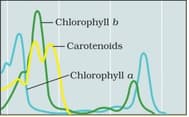Which of the following wavelengths of light is most effective for photosynthesis?
Important Questions on Photosynthesis
A student working in a lab had three tubes with the following preparations:
(i) Freshly extracted nucleic acids dissolved in a buffer.
(ii) Chlorophyll extracted from spinach leaf.
(iii) Red coloured anthocyanin from onion cells.
The student used a spectrophotometer to determine the wavelength of light at which each preparation would show maximum absorption (absorption spectrum). She noted down the values in her notebook. However, when she came to the lab the next day, she realised that she had not mentioned the name of the sample preparation against each value. The values she recorded were 480 nm, 260 nm, and 642 nm. The respective values for the sample (i), (ii), and (iii) would most likely be:
The graph represents an:

Reason: In red drop phenomenon the rate of photosynthesis decreases.
Match the following and choose the correct combination from the given options.
| Column-I | Column- II |
|---|---|
| (A) Visible light | (1) 0.1 to 1 nm |
| (B) Ultra violet | (2) 400 to 700 nm |
| (C) X-rays | (3) Longer than 740 nm |
| (D) Infra-red | (4) 100 to 400 nm |
| (5) < 0.1 nm |

